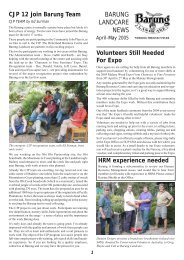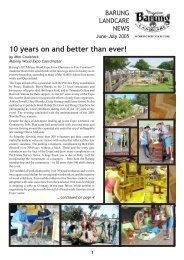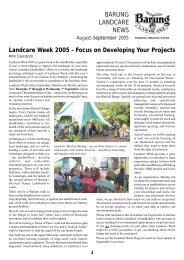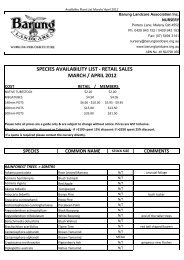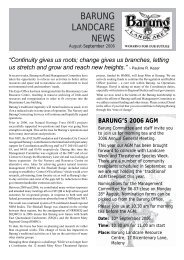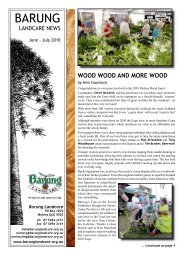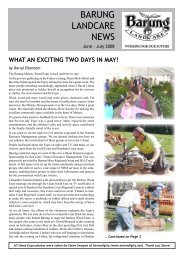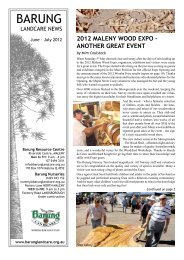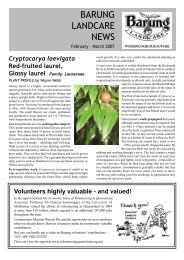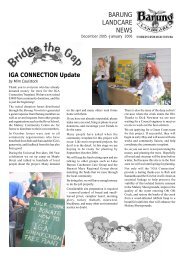Apr/May 2007 - Barung Landcare
Apr/May 2007 - Barung Landcare
Apr/May 2007 - Barung Landcare
Create successful ePaper yourself
Turn your PDF publications into a flip-book with our unique Google optimized e-Paper software.
Mischarytera lautereriana<br />
Corduroy tamarind<br />
Family: Sapindaceae<br />
PLANT PROFILE<br />
by Wayne Webb & Diana O’Connor<br />
Mischarytera lautereriana is a very<br />
handsome tree on account of its dense<br />
elegant foliage. The leaves are compound,<br />
about 25 cms long, divided into 10 to 20<br />
narrow leaflets with wavy margins giving<br />
a lovely feathery look to the foliage. The<br />
shiny leaflets are hairless, bright green<br />
and entire with small teeth near the apex.<br />
There is a large pulvinus (swelling) at the<br />
base of the leaf stem. Bright red flushes of<br />
new growth are very ornamental.<br />
Corduroy tamarind is a small to medium<br />
sized tree of subtropical rainforest growing<br />
to around 15 m, although old specimens to<br />
30 m can be found in mature rainforests.<br />
It occurs north from Mt Glorious (near<br />
Brisbane) to the Windsor Tableland<br />
(west of the Daintree). It is endemic to<br />
Queensland. It is quite common locally,<br />
often found close to watercourses. Examples may be seen in<br />
Mary Cairncross Scenic Reserve down near the piccabeen<br />
grove. Other places include Flaxton, Elaman Ck, Peachester,<br />
Landsborough and Mapleton.<br />
The trunk has horizontally ridged grey bark, common in<br />
this family. The common name comes from the strangely<br />
undulating sapwood (like corduroy) lying below the bark,<br />
and the sharp taste (like tamarind) of the fruit’s edible aril.<br />
Corduroy tamarind bears tiny fragrant flowers in panicles<br />
near the ends of branches in <strong>May</strong> and June. It usually<br />
by Ashley Sewell and Mim Coulstock<br />
Mischarytera lautereriana<br />
[Photo by Wayne Webb]<br />
When Patricia and Phil Jacobs came from Sydney to Maleny in<br />
1991, they purchased a 2.6 ha property on Gardners Lane and<br />
proceeded to build their house and to rehabilitate and landscape<br />
the surrounding ex-dairy farm land. With their strong commitment<br />
to the community, especially when <strong>Barung</strong> <strong>Landcare</strong> was in its<br />
infancy with Lexie Forbes at the helm, Patricia and Phil provided<br />
invaluable support operating and even building the office.<br />
Phil and Patricia were early and strong supporters of what was to<br />
become known ‘farm forestry’. Using the ‘Jack Mitchell Method’<br />
of planting 10-12 species of cabinet timbers per hectare, two<br />
small 1000 m farm forestry plots were established in 1992-94 on<br />
their property in Gardners Lane. These plantings have been very<br />
successful, and have provided sound demonstration opportunities<br />
for interested and potential farm forestry growers in the region.<br />
Phil and Patricia’s sites are still used for <strong>Barung</strong> Farm Forestry<br />
tours for local, school and overseas visitors.<br />
Since Phil passed away in 2001, Patricia has maintained their<br />
property in excellent condition in his absence. However, to make<br />
<br />
fruits in November and December (though in <strong>2007</strong> fruiting<br />
occurred in January). Like many rainforest species, it may<br />
fruit heavily in some years and hardly at all in other years.<br />
The fruit is a three-lobed capsule (although often only one<br />
lobe will develop) that opens upwards to expose the fleshy<br />
orange aril which encases a large brown seed.<br />
Corduroy tamarind makes a very attractive garden or park<br />
tree. Young trees have a stately conical outline,<br />
with a dense canopy of beautiful wavy foliage.<br />
Older trees develop a rounded crown. This<br />
species is hardy in full sun, tolerates light frost,<br />
and will grow in a variety of soils including<br />
shallow infertile soils. It establishes faster with<br />
some protection and good mulching when<br />
young. Larger trees in the rainforest often have<br />
a carpet underneath of young ones often up to<br />
one metre high. This suggests it could be mass<br />
planted in heavily shaded areas of the garden<br />
to produce a beautiful ferny understorey, the<br />
low light levels suppressing growth.<br />
The juicy orange aril is edible, though very<br />
tart. If removed carefully when cleaning the<br />
seed, the aril can be used to make a fantastic<br />
bright orange ‘bush-tucker’ jam – great with<br />
scones and whipped cream! The fruit is also<br />
sought out by rainforest birds such as the<br />
wompoo fruit-dove. The wood of this species has been used<br />
for flooring and scantling.<br />
Corduroy tamarind is easily propagated from seed, which<br />
germinates in a few weeks. The seed is subject to insect<br />
attack while on the tree, so when collecting soak the seed<br />
overnight in water to drown any grubs. Remove the flesh<br />
and discard any seeds that are distorted before sowing. If<br />
seeds can’t be sown immediately, they may be soaked for<br />
one or two weeks; they will loose viability if allowed to<br />
dry out for too long.<br />
Phil and Patricia Jacobs: <strong>Barung</strong> & Farm Forestry Stalwarts<br />
the property more manageable for herself, she has decided to<br />
subdivide and sell one block, containing one of the farm forestry<br />
plots, hopefully to a sympathetic farm forestry or landcaring<br />
enthusiast.<br />
It is hoped that the purchaser will continue to permit <strong>Barung</strong><br />
<strong>Landcare</strong> to use the forestry plot for demonstration and educational<br />
purposes.<br />
FARM FORESTRY LAND FOR SALE<br />
1.021 hectares of ‘Farm Forestry’ land<br />
including a mixed species cabinet timber tree plot<br />
and spring-fed dam<br />
in North Maleny<br />
(part of the property of the late Phil Jacobs)<br />
Phone: Patricia Jacobs on 5494 3464



